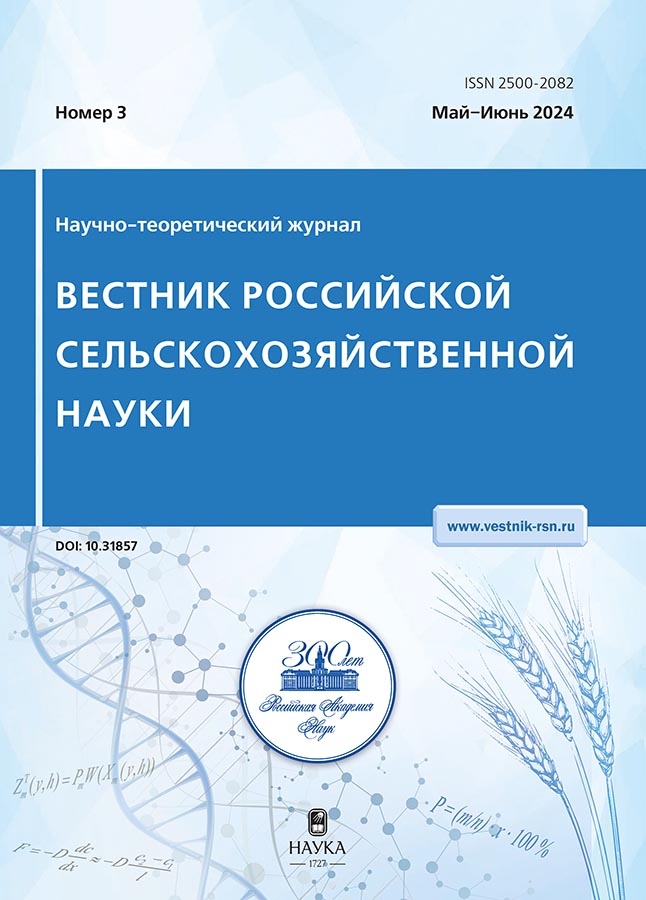Productivity of the Kitrossa soybean variety depends on reproductive organs formation
- Autores: Levina A.N.1
-
Afiliações:
- Federal Scientific Center “All-Russian Research Institute of Soybeans”
- Edição: Nº 3 (2024)
- Páginas: 34-37
- Seção: Crop Production and Selection
- URL: https://vietnamjournal.ru/2500-2082/article/view/659308
- DOI: https://doi.org/10.31857/S2500208224030076
- EDN: https://elibrary.ru/yxrsvp
- ID: 659308
Citar
Texto integral
Resumo
The research was carried out under the conditions of a growing experiment in the Laboratory of Plant Physiology and Biochemistry of the Federal State Budgetary Institution Federal Scientific Center All-Russian Research Institute of Soybeans with the mid-season soybean variety Kitrossa. In 2021–2023, plant productivity was studied depending on the formation of reproductive organs during the growing season at two sowing dates – May 20 and May 25. It was found that the largest number of reproductive organs was formed at the sowing date of May 20, the number of flowers on plants was 41 more per plant, the number of bean ovaries was greater by 21, and the number of beans was 3 more per plant compared to plants with the sowing date May 25. The highest abortion rate was detected among flowers when sowing on May 25 (51,1%), when sowing on May 20 it was 10,8% less. The fall of beans when sowing on May 20 was 15,4%, in plants with the sowing date of May 25 – 18,2%. The lowest abortivity of seeds in beans was detected when sowing on May 20, which had a positive effect on the productivity value. As a result, a tendency was established to increase the productivity of Kitrossa soybean plants by 0,94 g/plant. when sowing on May 20 relative to this indicator for the option with a sowing date of May 25. A close correlation between plant productivity and quantity was revealed. Correlation coefficients ranged from 0,74 to 0,99 (rcrit = 0,57) depending on the sowing period. According to the studied indicators of the formation and abortion of reproductive organs, as well as seed productivity, favorable conditions for plants were at the sowing date of May 20.
Palavras-chave
Texto integral
Sobre autores
A. Levina
Federal Scientific Center “All-Russian Research Institute of Soybeans”
Autor responsável pela correspondência
Email: lan@vniisoi.ru
Rússia, Blagoveshchensk
Bibliografia
- Dospekhov B.A. Metodika polevogo opyta s osnovami statisticheskoj obrabotki rezul’tatov issledovanij. M.: Al’yans, 2014. 352 s.
- Zhurbickij Z.I. Teoriya i praktika vegetacionnogo metoda. M.: Izd-vo «Nauka», 1968. 260 s.
- Zubkova E.N., Belova T.A. Fiziologiya fotoperiodicheskoj chuvstvitel’nosti u rastitel’nyh organizmov pri razlichnoj prodolzhitel’nosti svetovogo perioda // Vestnik RUDN. Seriya: Ekologiya i bezopasnost’ zhiznedeyatel’nosti. 2017. № 1. S. 50–57. doi: 10.22363/2313-2310-2017-25-1-50-57. EDN: YMRWPJ.
- Lopatkina E.F. Metodika kolichestvennogo ucheta reproduktivnyh organov soi // Nauch.-tekh. byul. VNII soi: CHastnye voprosy genetiki, biologii i fiziologii soi. 1977. Novosibirsk, Vyp. 7–8. S. 34–42.
- Metodika gosudarstvennogo sortoispytaniya sel’skohozyajstvennyh kul’tur. M., 1989. 195 s.
- Sinegovskaya V.T. Vliyanie sroka poseva na formirovanie reproduktivnyh organov i produktivnost’ semyan skorospelogo sorta soi Sentyabrinka // Agronauka. 2023. T. 1. № 3. S. 23–28. doi: 10.24412/2949-2211-2023-1-3-23-28. EDN: ZXEFTJ.
- Sinegovskaya V.T. Crops of soybean in the Amur region as photosynthetic system. Blagoveshchensk, 2002. 120 p.
- Tikhonchuk P.V., Oborskaya Yu.V., Yushchenko B.I. Productivity of soybean varieties at different sowing dates // Far Eastern Agrarian Bulletin. 2007. No. 1. pp. 62–68.
- Ugo T.K. Produktivnost’ agrocenoza soi rannespelogo sorta Del’ta v zavisimosti ot sroka poseva // Maslichnye kul’tury. 2006. № 1 (134). S. 65–69
- Ustyuzhanin A.P., Shevchenko A.V., Tur’yanskij V.E. Selekciya sortov soi severnogo ekotipa // Voronezh: Voronezhskij GAU, 2007. 225 s.
- Fokina E.M., Belyaeva G.N., Sinegovskij M.O. i dr. Katalog sortov soi. Blagoveshchensk: OOO «INK “ODEON”», 2021. 69 s.
- Hramoj V.K., Siharulidze T.D., Rahimova O.V. Obosnovanie optimal’nogo sroka poseva soi v usloviyah Central’nogo rajona Nechernozemnoj zony // Vestnik Ul’yanovskoj GSKHA. 2018. № 3 (43). S. 89–92.
- Yudin F.A. Metodika agrohimicheskih issledovanij. 2-e izd., pererab., i dop M.: Kolos, 1980. 366 s.
- Fehr W.R., Caviness C.E., Burmood D.T., Pennington J.S. Stages of development descriptions for soybeans, Glycine max. (L) Merr. // Crop Sci. 1971. № 11. PP. 929–930.
- Zhang L.X., Liu W., Tsegaw M., et al. Principles and practices of the photo-thermal adaptability improvement in soybean // Journal of integrative agriculture. 2020. Vol. 19. No. 2. PP. 295–310. doi: 10.1016/S2095-3119(19)62850-9
Arquivos suplementares












